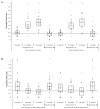The development of visual search in infancy: Attention to faces versus salience
- PMID: 26866728
- PMCID: PMC4808329
- DOI: 10.1037/dev0000080
The development of visual search in infancy: Attention to faces versus salience
Abstract
Four experiments examined how faces compete with physically salient stimuli for the control of attention in 4-, 6-, and 8-month-old infants (N = 117 total). Three computational models were used to quantify physical salience. We presented infants with visual search arrays containing a face and familiar object(s), such as shoes and flowers. Six- and 8-month-old infants looked first and longest at faces; their looking was not strongly influenced by physical salience. In contrast, 4-month-old infants showed a visual preference for the face only when the arrays contained 2 items and the competitor was relatively low in salience. When the arrays contained many items or the only competitor was relatively high in salience, 4-month-old infants' looks were more often directed at the most salient item. Thus, over ages of 4 to 8 months, physical salience has a decreasing influence and faces have an increasing influence on where and how long infants look.
(c) 2016 APA, all rights reserved).
Figures








References
-
- Adams RJ. An evaluation of color preference in early infancy. Infant Behavior and Development. 1987;10(2):143–150. doi: 10.1016/0163-6383(87)90029-4. - DOI
-
- Adler SA, Orprecio J. The eyes have it: Visual pop-out in infants and adults. Developmental Science. 2006;9(2):189–206. doi: http://dx.doi.org/10.1111/j.1467-7687.2006.00479.x. - DOI - PubMed
-
- Althaus N, Mareschal D. Using saliency maps to separate competing processes in infant visual cognition. Child development. 2012;83(4):1122–1128. - PubMed
Publication types
MeSH terms
Grants and funding
LinkOut - more resources
Full Text Sources
Other Literature Sources
Medical

